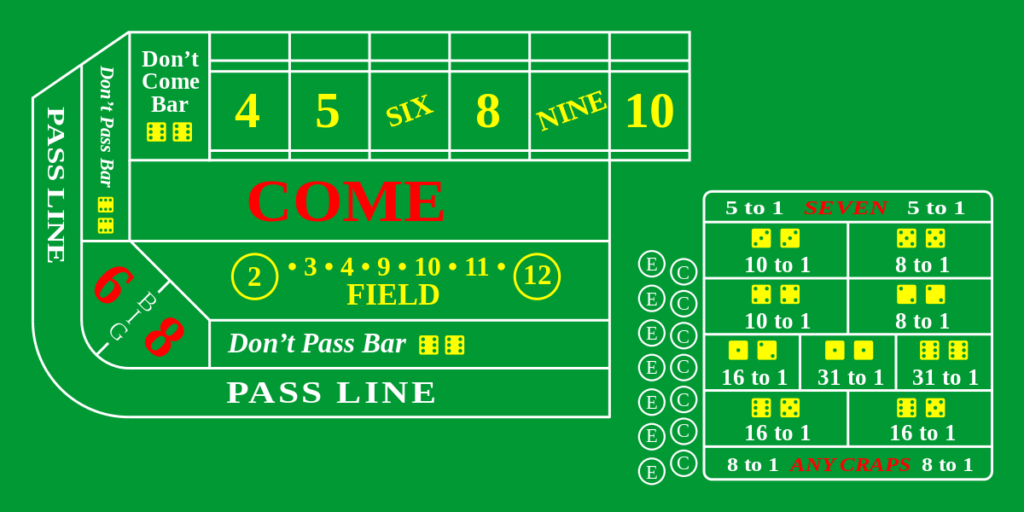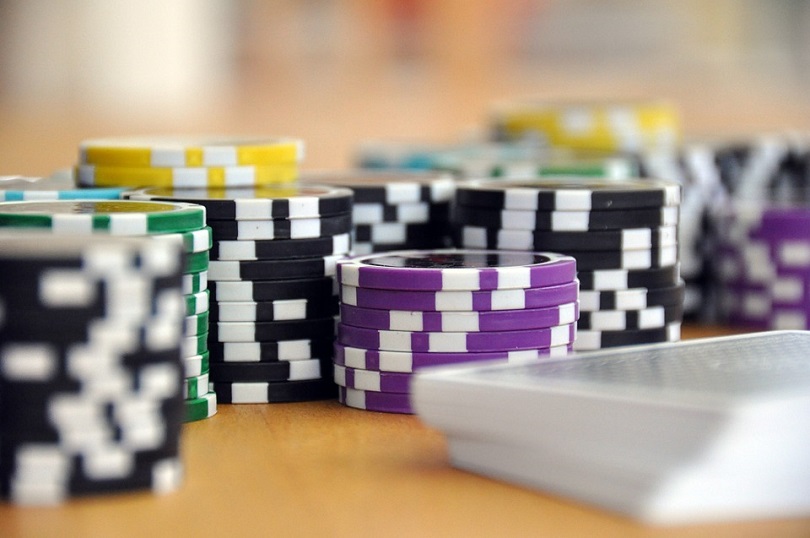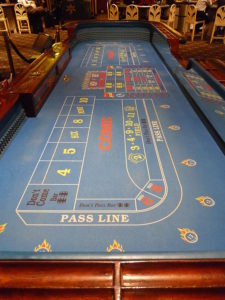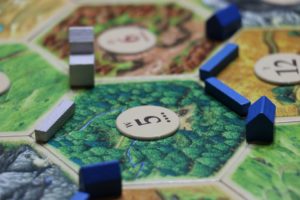What is Craps?
At a basic level, you are betting on the roll of a dice. When starting the game or when it is “coming out”, the number is off / black, then you bet on the pass line, winning 1:1 when a 7 or 11 is rolled, and losing your wager when a 2, 3, or 12 is rolled. For those who play dice games – especially Settlers of Catan (see below) – it is all about the odds and percentages. If any other number is rolled, that number becomes the Point. Then, the dice roller, or “shooter” as it’s called, wants to roll that number again before a 7 is rolled.
Craps has some of the best odds in the house, especially with the notion of free odds where you can effectively mitigate, but not eliminate, the house advantage (HA). By combining the pass line bet (with a HA of ~1.41%) with free odds (which pay true value, and the HA is 0%), you can amortize the 1.41% over a larger bet – reducing the overall HA closer to 0%!
There are other bets, most common the come bet and place bets, which also bet on numbers being rolled again before a 7. These have similarly low house advantages of 1-2%, up to 4-7% for 5/9 and 4/10. In the middle of the craps table are several more selective bets, known as proposition or “prop” bets. These offer higher payouts of 11:1 or 30:1, but also have much higher house advantages of 10+%. My goal is to minimize my losses, and maximize my entertainment and time, and so I stay away from such bets.

Craps Table, note that the payouts in the right side should be “for 1” rather than “to 1” from wikimedia: Betzaar.com
Why Settlers of Catan is great for this game
You may have heard of Settlers of Catan, a great multiplayer strategy board game by Mayfair Games, where players compete to gain resources and build their domains. If you’ve played, you may have noticed the dots below each number in the game. The number of dots represents the different possible ways to roll the stated number (i.e. four dots on the “5” count the four ways to roll a “5” – (1,4), (2,3), (3,2), and (4,1). Most grasp that the more dots means more likelihood of rolling that number, but in fact it is exactly the number of ways to roll the number. For example, a “6” has five dots underneath, for the five possible ways.
Catan teaches you the probabilities, making it easier to connect the numbers and odds. Since craps compares everything to a 7 (with 6 ways), you can easily tell payouts by dividing those 6 ways to lose by the 3-5 ways of winning. For example, if the number is 5, you want a 5 to be rolled again, before a 7 is rolled. There are four ways (above) to win, and 6 ways to lose (since there are 6 ways to roll a 7), out of a possible 36 dice combinations.
Thus, if you have free odds, the house will pay out $3 for every $2 wagered on those free odds, calculated by dividing the six chances to lose by the four ways to win. You can never truly eliminate the house advantage in craps (otherwise they wouldn’t be profitable) but you can certainly reduce it by using free odds.
Or, if you’ve never played Settlers of Catan, try it yourself through the various resources available online! See below for more information.
Studying and My Craps Experience
Craps is important to me because it was the first game that I learned specifically for a casino. A couple months before my 22nd birthday, I studied Wikipedia and Wizard of Odds daily to understand all the various components, odds, percentages, and options of craps. I used Wizard’s craps simulator, and set off for the Venetian in my second ever Vegas trip. (I discount my first trip, as it was more exploratory, checking out all the casinos and taking advantage of all the American Casino Guide coupons).
The Venetian, due to the time of year, had a higher-than-desired $15 minimum, but I played for several hours. I stuck to what I was “taught” – the lowest house advantage bets, which were pass line, free odds (which were the standard 3x/4x/5x at the time) and place bets on 6 and 8 for $18 apiece. Quite nerve-wracking (for me) to have nearly $100 on the table at a time. Thankfully, I more than doubled my bankroll, winning just under $400. It was an amazing experience, but rarely repeated.
Since then I have attempted my luck at other casinos, and have only achieved it once at a casino in Los Angeles. Playing poker there earned me $40 an hour, but switching to craps and their bizarre dice/card game (thank you California and your regulation) netted me $400 an hour. However, I have also lost several times, and limit my play. The stress and heart palpitations during the dice roll are a bit overwhelming. I experience this on a regular basis, be it for a $5 bet or a $50 roll.
Conclusion
Craps is a game that looks complex, but can be distilled to a very basic level and simple to learn. It’s fun to try and explore. Find it for $5 (or even less at $3!) on the Las Vegas Strip. Most of the nicer casinos in Las Vegas, and other stand-alone casinos on the east coast, will have minimums closer to $15-$25, or even $50-$100 during high traffic times. This game is designed for those who can weather big swings, have an appetite for risk, and want to engage with both other players and craps croupiers. It will always be a fond memory for me, and I will try it from time to time, but I reserve my bankroll for other opportunities.
Featured Image from Pixabay, by fielperson
What do you think of my standpoint on Craps? Have any questions? Let me know in the comments, or reach me directly at TheHotelion@gmail.com! Like my posts? See more here, on TravelUpdate! Follow me on Facebook (The Hotelion) or on Twitter and Instagram: @TheHotelion







Nice!!!!Wow
Thanks for reading!
This is great. Do you have a write-up like this for roulette?
Hi Ali, I currently do not but if there is enough interest I can write one. I definitely researched it the same time, but found it much different (and higher house advantage). Please let me know and I will see if I can write it up.
Hi Daniel – Yes I’d be very interested in that. The few times I play, I usually bet two rows or two quadrants for an almost 2/3 chance of winning 2x your initial bet. I’m curious of a professionals thoughts on this and if there are any other tips. Thanks!
Wizard of Odds and Wikipedia have done a thorough analysis of roulette – I believe it said 5.26% house advantage. Most (or all) of the bets have the same high house advantage. Because craps/blackjack is lower, I tend to stay with those games.